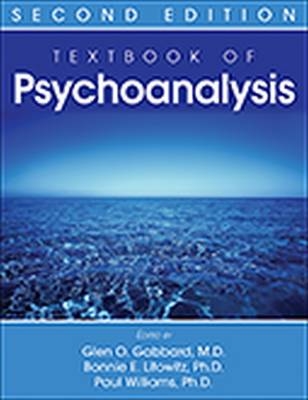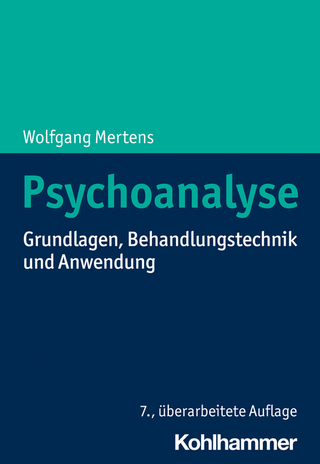
Textbook of Psychoanalysis
American Psychiatric Association Publishing (Verlag)
978-1-58562-410-2 (ISBN)
- Titel erscheint in neuer Auflage
- Artikel merken
The second edition of this groundbreaking text represents a complete departure from the structure and format of its predecessor. Though still exhaustive in scope and designed to provide a knowledge base for a broad audience—from the beginning student to the seasoned analyst or academician—this revision emphasizes the interdisciplinary nature of psychoanalytic thought and boldly focuses on current American psychoanalysis in all its conceptual and clinical diversity. This approach reflects the perspective of the two new co-editors, whose backgrounds in linguistics and social anthropology inform and enrich their clinical practice, and the six new section editors, who themselves reflect the diversity of backgrounds and thinking in contemporary American psychoanalysis.
The book begins with Freud and his circle, and the origins of psychoanalysis, and goes on to explore its development in the post-Freud era. This general introduction orients the reader and helps to contextualize the six sections that follow.
• The most important tenets of psychoanalysis are defined and described in the "Core Concepts" section, including theories of motivation, unconscious processes, transference and countertransference, defense and resistance, and gender and sexuality). These eight chapters constitute an excellent introduction to the field of psychoanalysis.
• The "Schools of Thought" section features chapters on the most influential theories—from object relations to self psychology, to attachment theory and relational psychoanalysis, and includes the contributions of Klein and Bion and of Lacan.
• Rather than making developmental theory a separate section, as in the last edition, developmental themes now permeate the "Schools of Thought" section and illuminate other theories and topics throughout the edition.
• Taking a more clinical turn, the "Treatment and Technique" section addresses critical subjects such as transference and countertransference; theories of therapeutic action; process, interpretation, and resistance, termination and reanalysis; combined psychoanalysis and psychopharmacotherapy, child analysis, ethics, and the relationship between psychoanalysis and psychodynamic psychotherapy.
• A substantive, utterly current, and meticulously referenced section on "Research" provides an in-depth discussion of outcome, process, and developmental research.
• The section entitled "Psychoanalysis and Other Disciplines" takes the reader on a fascinating tour through the many fields that psychoanalysis has enriched and been enriched by, including the neurosciences, philosophy, anthropology, race/ethnicity, literature, visual arts, film, and music.
• A comprehensive Glossary completes this indispensable text.
The Textbook of Psychoanalysis is the only comprehensive textbook of psychoanalysis available in the United States. This masterful revision will both instruct and engage those who are learning psychoanalysis, those who practice it, and those who apply its theories to related disciplines. Though always controversial, this model of the human psyche still provides the best and most comprehensive insight into human nature.
Glen O. Gabbard, M.D., is Professor of Psychiatry at SUNY Upstate Medical University in Syracuse, New York; Clinical Professor of Psychiatry at Baylor College of Medicine in Houston, Texas; and Training and Supervising Analyst at the Center for Psychoanalytic Studies in Houston, Texas. Bonnie E. Litowitz, Ph.D., is Associate Professor in the Department of Psychiatry at Rush Medical School and is also on the faculty at the Chicago Institute for Psychoanalysis. Paul Williams, Ph.D., is a training and supervising analyst with the British Psychoanalytical Society.
Contributors
Introduction
SECTION I: General Introduction
Chapter 1. Freud and His Circle
Chapter 2. Psychoanalysis in North America After Freud
SECTION II: Core Concepts
Chapter 3. Theories of Motivation
Chapter 4. Unconscious Processes
Chapter 5. Transference
Chapter 6. Countertransference: An Instrument of the Analysis
Chapter 7. Defense and Resistance
Chapter 8. Intersubjectivity
Chapter 9. Childhood Experiences and the Adult World
Chapter 10. Gender and Sexuality
SECTION III: Schools of Thought
Chapter 11. Classical Psychoanalysis: Past and Present
Chapter 12. Object Relations
Chapter 13. Klein and Bion
Chapter 14. Self Psychology
Chapter 15. Relational Psychoanalysis
Chapter 16. Jacques Lacan
Chapter 17. Infant Research and Adult Psychotherapy
SECTION IV: Treatment and Technique
Chapter 18. Transference, Countertransference, and the Real Relationship
Chapter 19. Theories of Therapeutic Action and Their Clinical Consequences
Chapter 20. Process, Resistance, and Interpretation
Chapter 21. Termination and Reanalysis
Chapter 22. Combining Psychoanalysis and Psychopharmacology: Theory and Technique
Chapter 23. Technique in Child Analysis
Chapter 24. Ethics in Psychoanalysis
Chapter 25. Psychoanalysis and Psychodynamic Psychotherapy: Historical Development and Present Relationship
SECTION V: Research
Chapter 26. Research on Outcomes of Psychoanalysis and Psychoanalysis-Derived Psychotherapies
Chapter 27. Psychoanalytic Process Research
Chapter 28. Developmental Research
SECTION VI: Psychoanalysis and Other Disciplines
Chapter 29. Psychoanalysis and the Neurosciences
Chapter 30. Psychoanalysis and Philosophy
Chapter 31. Psychoanalysis and Anthropology
Chapter 32. Race, Ethnicity, and Nationality
Chapter 33. Psychoanalysis and Literature
Chapter 34. Psychoanalysis and the Visual Arts
Chapter 35. Psychoanalysis and Film
Chapter 36. Psychoanalysis and Music
Glossary
Index
| Erscheint lt. Verlag | 14.1.2012 |
|---|---|
| Zusatzinfo | 4 Line drawings, black and white; 4 Tables, unspecified |
| Verlagsort | VA |
| Sprache | englisch |
| Maße | 216 x 279 mm |
| Gewicht | 1914 g |
| Themenwelt | Geisteswissenschaften ► Psychologie ► Psychoanalyse / Tiefenpsychologie |
| Medizin / Pharmazie ► Medizinische Fachgebiete ► Psychiatrie / Psychotherapie | |
| ISBN-10 | 1-58562-410-1 / 1585624101 |
| ISBN-13 | 978-1-58562-410-2 / 9781585624102 |
| Zustand | Neuware |
| Haben Sie eine Frage zum Produkt? |
aus dem Bereich



